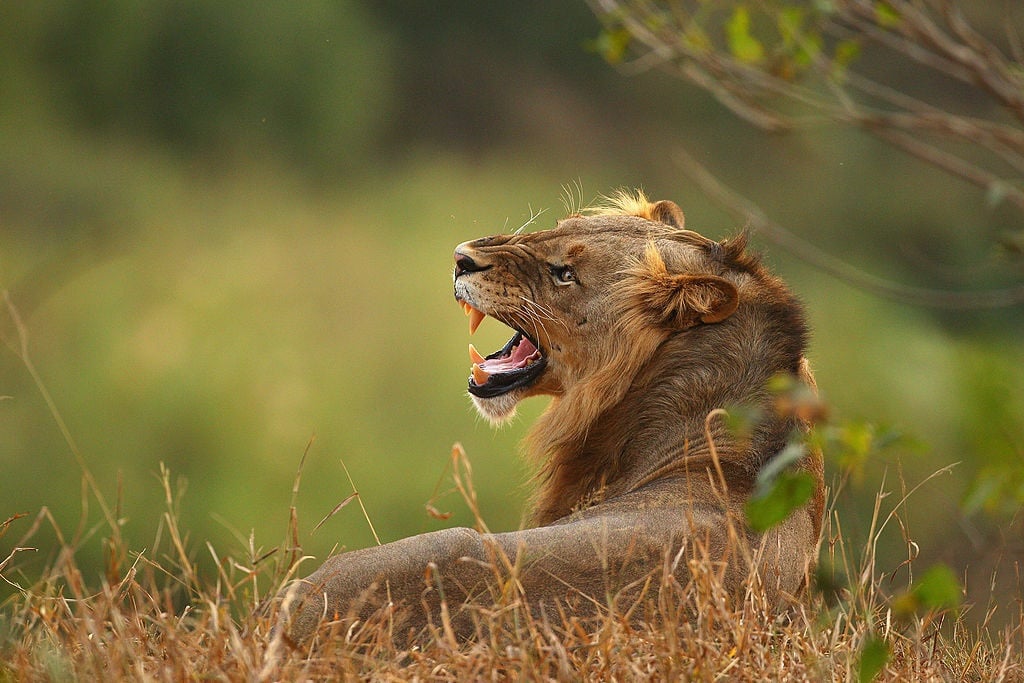
- Wildlife was almost wiped out by civil war at Angola's Luengue-Luiana National Park.
- Only 30 lions have been re-introduced despite the park having the capacity to house thousands.
- Human-wildlife conflict and rampant poaching at the park are a setback.
- Landmines planted at the park during Angola's civil war pose a danger.
Prince Harry paid a visit to Luengue-Luiana National Park (LLNP) in Angola in 2019 to draw attention to the terrible toll that decades of civil war had taken on the park's inhabitants and wildlife.
He urged for the park's rehabilitation so that "wildlife can be free to return to where they once roamed, and Angolans can reap the rewards".
The only conservation charity operating in the 42 000sq km park, Panthera, has been working to restore this vital wildlife habitat for lions, cheetahs, African wild dogs, and other species for nearly four years. Although the park can house thousands of lions, it now has less than 30.
It is a significant part of the Kavango-Zambezi Transfrontier Protection Area (KAZA), which spans 520 000km2 of Namibia, Zambia, Zimbabwe, Angola, and Botswana.
In comparison, it is larger than France.
News24 spoke to Willem Nieman, the project manager at LLNP, about the journey of returning a former rebel base to a wildlife sanctuary.
Which animal species were largely affected by the civil war in Angola?
Willem Nieman: Wildlife in protected areas such as LLNP was severely decimated during the Angolan Civil War (1975-2002), and until now the impact has not been reversed. During the 1980s, south-east LLNP (then Luiana Partial Reserve) was the military operations centre for Unita (National Union for the Total Independence of Angola) – which used elephant ivory to pay for arms and meat.
Elephant numbers in particular were thus greatly impacted, with an international alarm called at the time with reports of up to 100 000 elephants killed, and only a few thousand remaining in Angola.
However, many other large mammals, such as zebra and kudu, were frequently hunted as bushmeat after military bases were established in LLNP and anti-poaching patrols were suspended as a consequence of the war.
Nonetheless, indirect effects of war, such as extensive minefields, resource extraction (for example, timber cutting and fishing), increased access to automatic and semi-automatic weapons, and the displacement of local communities, affected and continue to affect all wildlife species.
READ | EXPLAINER: Mapping out Angola's peatlands, which trap carbon and clean the region's water
That being said, however, the population status of most wildlife species appears to be improving in Panthera’s intensely managed areas within LLNP, and numbers have increased in recent years.
This follows data collected through Panthera camera trap surveys, which allows us to collect hundreds of thousands of photos of endangered species annually.
How do you monitor or track animal movements as well as determine the population estimates?
Nieman: We can determine the status and distribution of mammal species in the landscape, and potential trends in population abundance between years, and for species with distinct coat patterns (for example, leopard) we are even able to identify unique individuals and thus accurately calculate their density.
The first camera trap survey was conducted in 2015/2016, and follow-up surveys were completed in 2021 and 2022.
The 2023 survey period is currently under way, with roughly 200 camera traps deployed annually.
In all surveys, predators such as leopard, cheetah, African wild dog, spotted hyena, caracal, and serval were captured in good numbers.
Large prey species such as roan antelope, sable antelope, kudu, and buffalo were also relatively abundant, as well as elephants and smaller prey species; indicating that these areas of the park are providing sufficient refuge for wildlife populations to recover post-war.
Several species nonetheless remain rare, such as zebra, blue wildebeest, and impala, to name a few.
In the next five years, what's your projection for the lion population?
Nieman: In the landscape decimated by war and ongoing poaching, lion numbers seem to be particularly low.
From the 2015/2016 camera trap survey mentioned above, Panthera scientists estimated only about 10 to 30 lions remained in both LLNP and Mavinga National Park.
During the 2021 survey, no lions were found. However, in the 2022 survey, five individual lions were captured in camera traps.
In addition, Panthera community game guards on patrol recorded six direct and 94 indirect spoor sightings of lions while on patrol, indicating without a doubt that lions are still present in the landscape and providing good baseline information on lion distribution.
In addition, Panthera has initiated a human-lion conflict programme in LLNP in preparation for a planned translocation of 10 to 12 unrelated lion individuals by the end of 2024.
The programme intends to better prepare communities for living with lions through education and the provisioning of materials to construct lion-proof cattle kraals.
Ultimately, Panthera’s long-term vision for LLNP is to have a viable, self-sustaining lion population, comprising 150 to 225 lions.
How is Prince Harry involved in Panthera?
Nieman: Prince Harry is not directly involved in Panthera. However, he became associated with the area following a bid made by the Angolan government and The Halo Trust (a demining NGO) in 2019, to invest around R1 billion over five years to clear landmines surrounding the Angolan Okavango watershed, a river system that supports more than a million people and feeds the Okavango Delta.
The area is situated in the Cuando Cubango Province, surrounding LLNP and Mavinga National Park, and was one of the worst affected by the war.
Prince Harry attended this event in 2019, following in the footsteps of Princess Diana, who visited Angola in 1997.
Prince Harry also proceeded to destroy the first landmine in Dirico, a town just outside the border of LLNP, after which three minefields were cleared around Dirico.
The dedication of the Angolan government, The Halo Trust, and Prince Harry to clearing landmines in the region is invaluable, and massive strides have been made to clear landmines on the borders of LLNP and Mavinga National Parks. (The Halo Trust has cleared over 100 000 landmines in Angola since 1994.)
However, little clearing of landmines has occurred to date in the parks, and the majority of the two parks thus remain inaccessible due to minefields.
There is an urgent need for future landmine clearing efforts to be conducted inside the national parks, since it continues to pose a significant threat to human lives, and hinders conservation efforts and economic development.
How have climate change and hunger affected the project and what measures are in place to guarantee that the animals have water?
Nieman: While no direct links between climate change/hunger and our project are evident at this time, it may be presumed that climate change will inevitably lead to extended periods of drought, which in turn will result in food shortage, cattle dying from disease, and malnourished children.
In recognition of this, Angola signed an agreement with the International Conservation Fund (ICCF) for, amongst others, the conservation of LLNP in the face of climate change in 2021, and Angola has approved the National Strategy for Climate Change 2021-2035, aimed at reaching the objectives set out in the Paris Agreement.
However, the water sources in Angola are, at this stage, fairly unexploited. Also, given the location of LLNP between the perennial Cuando (east) and Cuito (west) Rivers, as well as between the Okavango Catchment in the north and the Okavango Basin in the south (Botswana), ample water is available in most parts of LLNP throughout the year.
Since there are close to 20 000 people who live within the park, how bad is the human-to-wildlife conflict and what measures are there for co-existence?
Nieman: The majority of the roughly 20 000 people residing in LLNP practice subsistence agriculture through the planting of crops and the rearing of stock.
This, together with the general tendency of local communities to establish settlements near water sources, the lack of defence of crops and livestock by farmers, the rising human population, and the increase in wildlife numbers all contribute to human-wildlife conflict deemed to be pervasive in the area.
Panthera, in collaboration with The Africa Range-Wide Cheetah Conservation Initiative (CCI), has worked towards securing information that can be used as a roadmap for both Panthera and other potential interested parties to future community outreach interventions and initiatives.
To do so, all major villages have been visited frequently since 2019.
READ | Rich Russians hit by travel curbs go hunting in Zimbabwe
Initial meetings focused on explaining the boundaries and purpose of the national park, how conservation could benefit communities, and the importance of preserving natural resources, sustainable harvesting practices, and local school visits to identify and support their needs.
From these meetings, we also provided the Angolan governmental authorities with comprehensive reports detailing recommendations on how to develop wildlife tourism, and increase employment with the establishment of a community conservancy.
Through all community visits, we aim to develop a sense of ownership and accountability. More recently, our focus has been on understanding human-wildlife conflict needs in local communities and consequently finding ways to mitigate conflict scenarios.
As such, Panthera will commence with constructing predator-proof kraals to protect stock later this year. Importantly, however, an urgent need exists to address human-wildlife conflict around water sources.
How bad is poaching and which animals are the most endangered?
Nieman: Both subsistence poaching for bushmeat and ivory poaching occur at relatively high levels in LLNP.
In 2019, Panthera initiated its Community Game Guard (CGG) programme as the first of its kind in the landscape.
Since then, the programme has grown to include 35 CGGs operating from nine permanent patrol bases.
These CGGs undergo intense training in patrol planning and formations, tactical communications, observational skills, human rights, fitness, GPS, and first aid training, and provide a daily on-the-ground presence to secure populations of vulnerable species through anti-poaching patrols.
Panthera’s CGGs patrol on average 15 to 16km on foot per day, actively removing illegal hunting equipment such as wire snares, firearms, and gin traps from the landscape, confiscating poached bushmeat and ivory, deterring poachers, and destroying poachers’ camps.
Over the past year, the CGGs have managed to recover nearly 50 wire snares, 12 gin traps, and 14kg of elephant ivory on average per month.
The News24 Africa Desk is supported by the Hanns Seidel Foundation. The stories produced through the Africa Desk and the opinions and statements that may be contained herein do not reflect those of the Hanns Seidel Foundation




 Publications
Publications
 Partners
Partners
























